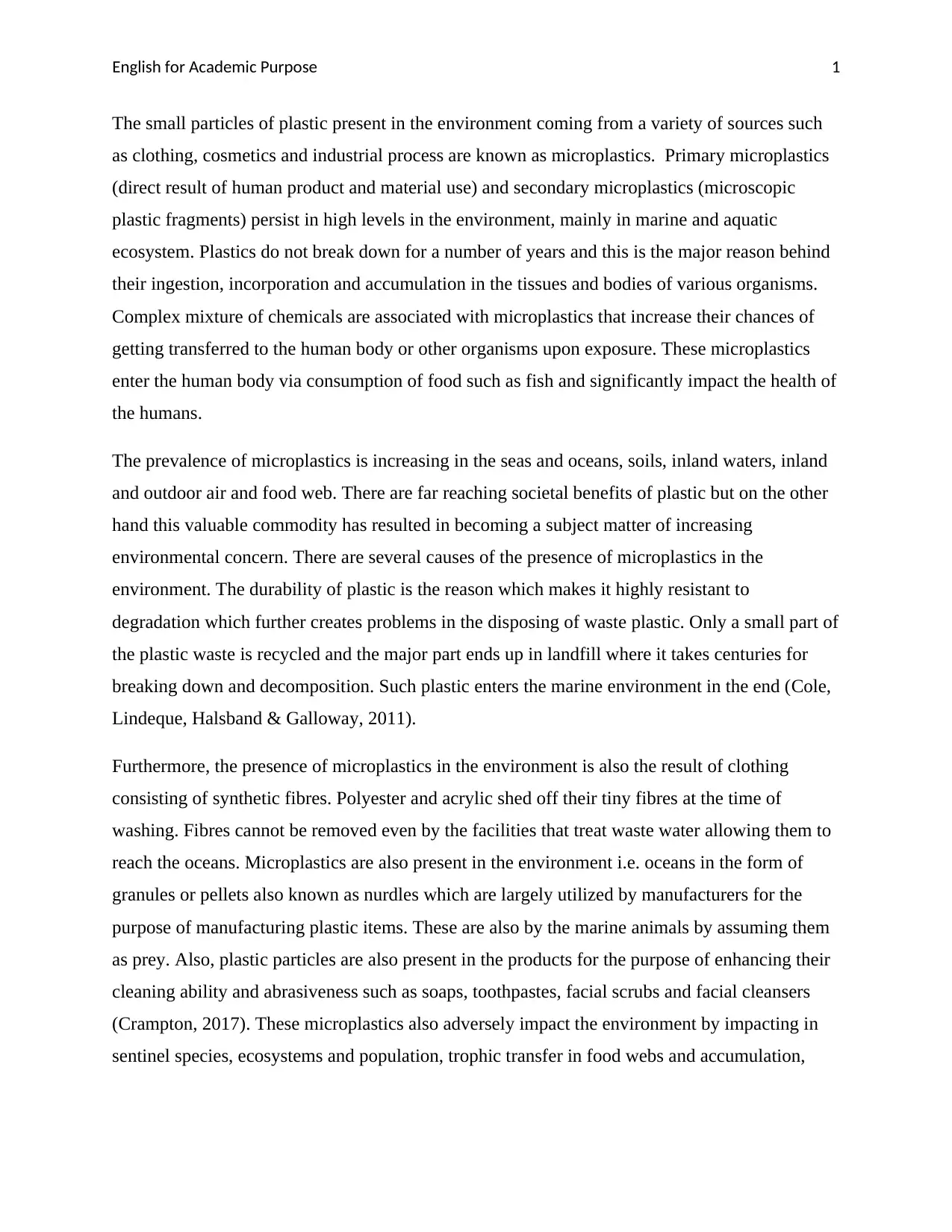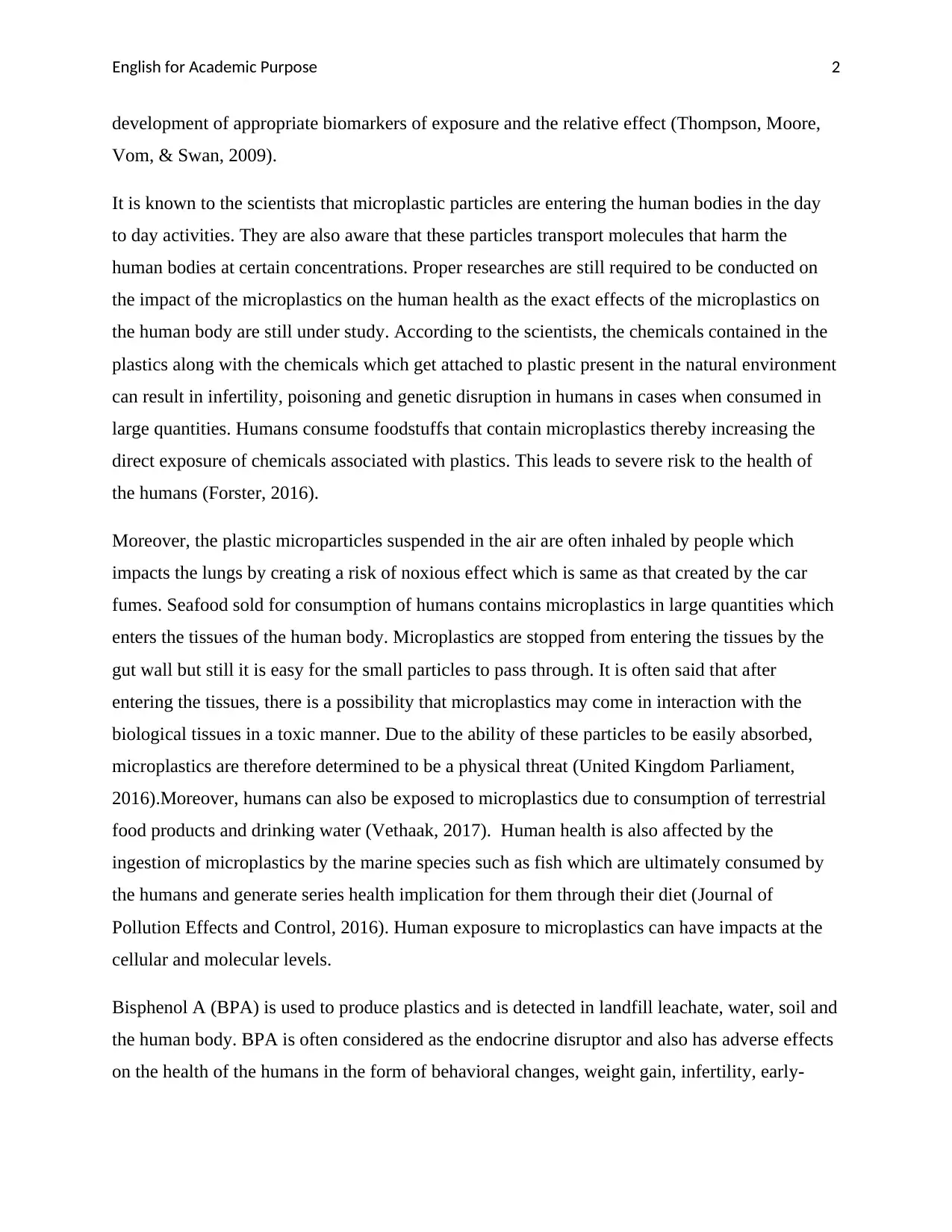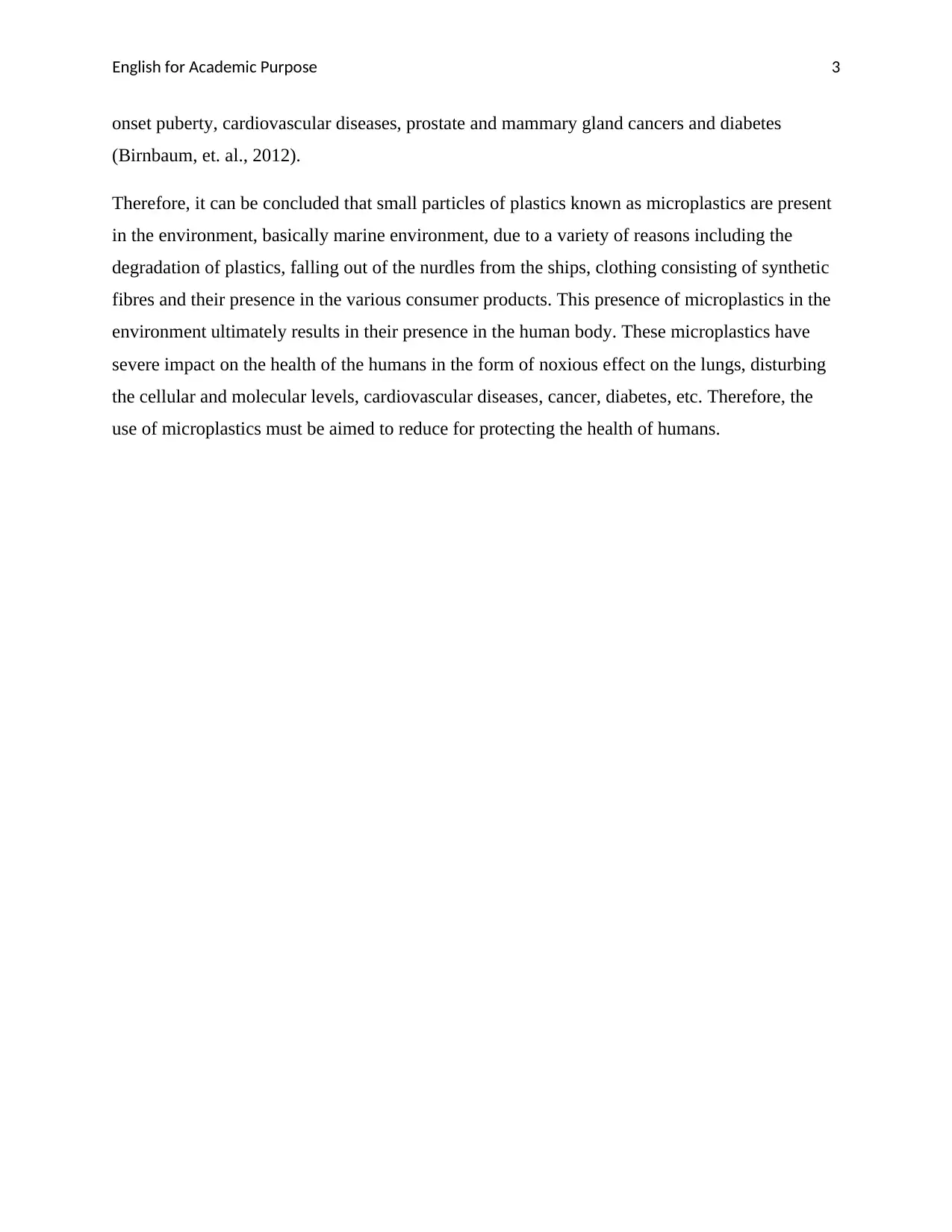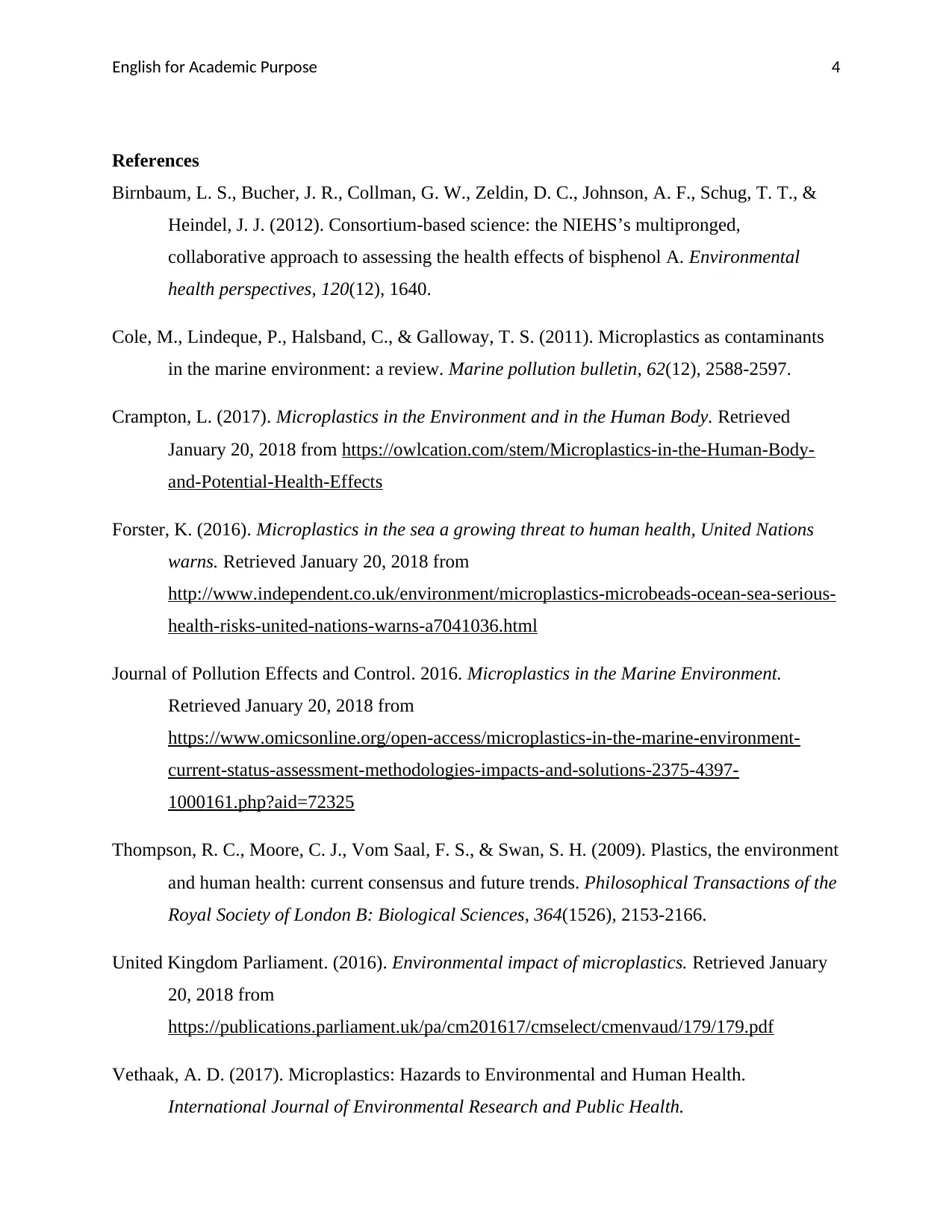Microplastics: Sources, Impacts, and Human Health Risks
VerifiedAdded on 2020/05/16
|5
|1373
|181
Essay
AI Summary
This essay examines the pervasive issue of microplastics, tiny plastic particles originating from various sources like clothing, cosmetics, and industrial processes, which are increasingly prevalent in marine and aquatic ecosystems. It highlights the durability of plastics and their resistance to degradation, leading to their accumulation in the environment and the ingestion by various organisms. The essay discusses the sources of microplastics, including synthetic clothing fibers, nurdles, and microplastics in consumer products, and their adverse impacts on ecosystems, trophic transfer, and human health. It emphasizes how microplastics enter the human body through food and air, carrying chemicals that can lead to infertility, poisoning, and genetic disruption. The essay concludes by underscoring the need to reduce microplastic use to protect human health, summarizing the various health impacts, including respiratory issues, cardiovascular diseases, and cancer.

RUNNING HEAD: English for Academic Purpose
English for Academic Purpose
English for Academic Purpose
Paraphrase This Document
Need a fresh take? Get an instant paraphrase of this document with our AI Paraphraser

English for Academic Purpose 1
The small particles of plastic present in the environment coming from a variety of sources such
as clothing, cosmetics and industrial process are known as microplastics. Primary microplastics
(direct result of human product and material use) and secondary microplastics (microscopic
plastic fragments) persist in high levels in the environment, mainly in marine and aquatic
ecosystem. Plastics do not break down for a number of years and this is the major reason behind
their ingestion, incorporation and accumulation in the tissues and bodies of various organisms.
Complex mixture of chemicals are associated with microplastics that increase their chances of
getting transferred to the human body or other organisms upon exposure. These microplastics
enter the human body via consumption of food such as fish and significantly impact the health of
the humans.
The prevalence of microplastics is increasing in the seas and oceans, soils, inland waters, inland
and outdoor air and food web. There are far reaching societal benefits of plastic but on the other
hand this valuable commodity has resulted in becoming a subject matter of increasing
environmental concern. There are several causes of the presence of microplastics in the
environment. The durability of plastic is the reason which makes it highly resistant to
degradation which further creates problems in the disposing of waste plastic. Only a small part of
the plastic waste is recycled and the major part ends up in landfill where it takes centuries for
breaking down and decomposition. Such plastic enters the marine environment in the end (Cole,
Lindeque, Halsband & Galloway, 2011).
Furthermore, the presence of microplastics in the environment is also the result of clothing
consisting of synthetic fibres. Polyester and acrylic shed off their tiny fibres at the time of
washing. Fibres cannot be removed even by the facilities that treat waste water allowing them to
reach the oceans. Microplastics are also present in the environment i.e. oceans in the form of
granules or pellets also known as nurdles which are largely utilized by manufacturers for the
purpose of manufacturing plastic items. These are also by the marine animals by assuming them
as prey. Also, plastic particles are also present in the products for the purpose of enhancing their
cleaning ability and abrasiveness such as soaps, toothpastes, facial scrubs and facial cleansers
(Crampton, 2017). These microplastics also adversely impact the environment by impacting in
sentinel species, ecosystems and population, trophic transfer in food webs and accumulation,
The small particles of plastic present in the environment coming from a variety of sources such
as clothing, cosmetics and industrial process are known as microplastics. Primary microplastics
(direct result of human product and material use) and secondary microplastics (microscopic
plastic fragments) persist in high levels in the environment, mainly in marine and aquatic
ecosystem. Plastics do not break down for a number of years and this is the major reason behind
their ingestion, incorporation and accumulation in the tissues and bodies of various organisms.
Complex mixture of chemicals are associated with microplastics that increase their chances of
getting transferred to the human body or other organisms upon exposure. These microplastics
enter the human body via consumption of food such as fish and significantly impact the health of
the humans.
The prevalence of microplastics is increasing in the seas and oceans, soils, inland waters, inland
and outdoor air and food web. There are far reaching societal benefits of plastic but on the other
hand this valuable commodity has resulted in becoming a subject matter of increasing
environmental concern. There are several causes of the presence of microplastics in the
environment. The durability of plastic is the reason which makes it highly resistant to
degradation which further creates problems in the disposing of waste plastic. Only a small part of
the plastic waste is recycled and the major part ends up in landfill where it takes centuries for
breaking down and decomposition. Such plastic enters the marine environment in the end (Cole,
Lindeque, Halsband & Galloway, 2011).
Furthermore, the presence of microplastics in the environment is also the result of clothing
consisting of synthetic fibres. Polyester and acrylic shed off their tiny fibres at the time of
washing. Fibres cannot be removed even by the facilities that treat waste water allowing them to
reach the oceans. Microplastics are also present in the environment i.e. oceans in the form of
granules or pellets also known as nurdles which are largely utilized by manufacturers for the
purpose of manufacturing plastic items. These are also by the marine animals by assuming them
as prey. Also, plastic particles are also present in the products for the purpose of enhancing their
cleaning ability and abrasiveness such as soaps, toothpastes, facial scrubs and facial cleansers
(Crampton, 2017). These microplastics also adversely impact the environment by impacting in
sentinel species, ecosystems and population, trophic transfer in food webs and accumulation,

English for Academic Purpose 2
development of appropriate biomarkers of exposure and the relative effect (Thompson, Moore,
Vom, & Swan, 2009).
It is known to the scientists that microplastic particles are entering the human bodies in the day
to day activities. They are also aware that these particles transport molecules that harm the
human bodies at certain concentrations. Proper researches are still required to be conducted on
the impact of the microplastics on the human health as the exact effects of the microplastics on
the human body are still under study. According to the scientists, the chemicals contained in the
plastics along with the chemicals which get attached to plastic present in the natural environment
can result in infertility, poisoning and genetic disruption in humans in cases when consumed in
large quantities. Humans consume foodstuffs that contain microplastics thereby increasing the
direct exposure of chemicals associated with plastics. This leads to severe risk to the health of
the humans (Forster, 2016).
Moreover, the plastic microparticles suspended in the air are often inhaled by people which
impacts the lungs by creating a risk of noxious effect which is same as that created by the car
fumes. Seafood sold for consumption of humans contains microplastics in large quantities which
enters the tissues of the human body. Microplastics are stopped from entering the tissues by the
gut wall but still it is easy for the small particles to pass through. It is often said that after
entering the tissues, there is a possibility that microplastics may come in interaction with the
biological tissues in a toxic manner. Due to the ability of these particles to be easily absorbed,
microplastics are therefore determined to be a physical threat (United Kingdom Parliament,
2016).Moreover, humans can also be exposed to microplastics due to consumption of terrestrial
food products and drinking water (Vethaak, 2017). Human health is also affected by the
ingestion of microplastics by the marine species such as fish which are ultimately consumed by
the humans and generate series health implication for them through their diet (Journal of
Pollution Effects and Control, 2016). Human exposure to microplastics can have impacts at the
cellular and molecular levels.
Bisphenol A (BPA) is used to produce plastics and is detected in landfill leachate, water, soil and
the human body. BPA is often considered as the endocrine disruptor and also has adverse effects
on the health of the humans in the form of behavioral changes, weight gain, infertility, early-
development of appropriate biomarkers of exposure and the relative effect (Thompson, Moore,
Vom, & Swan, 2009).
It is known to the scientists that microplastic particles are entering the human bodies in the day
to day activities. They are also aware that these particles transport molecules that harm the
human bodies at certain concentrations. Proper researches are still required to be conducted on
the impact of the microplastics on the human health as the exact effects of the microplastics on
the human body are still under study. According to the scientists, the chemicals contained in the
plastics along with the chemicals which get attached to plastic present in the natural environment
can result in infertility, poisoning and genetic disruption in humans in cases when consumed in
large quantities. Humans consume foodstuffs that contain microplastics thereby increasing the
direct exposure of chemicals associated with plastics. This leads to severe risk to the health of
the humans (Forster, 2016).
Moreover, the plastic microparticles suspended in the air are often inhaled by people which
impacts the lungs by creating a risk of noxious effect which is same as that created by the car
fumes. Seafood sold for consumption of humans contains microplastics in large quantities which
enters the tissues of the human body. Microplastics are stopped from entering the tissues by the
gut wall but still it is easy for the small particles to pass through. It is often said that after
entering the tissues, there is a possibility that microplastics may come in interaction with the
biological tissues in a toxic manner. Due to the ability of these particles to be easily absorbed,
microplastics are therefore determined to be a physical threat (United Kingdom Parliament,
2016).Moreover, humans can also be exposed to microplastics due to consumption of terrestrial
food products and drinking water (Vethaak, 2017). Human health is also affected by the
ingestion of microplastics by the marine species such as fish which are ultimately consumed by
the humans and generate series health implication for them through their diet (Journal of
Pollution Effects and Control, 2016). Human exposure to microplastics can have impacts at the
cellular and molecular levels.
Bisphenol A (BPA) is used to produce plastics and is detected in landfill leachate, water, soil and
the human body. BPA is often considered as the endocrine disruptor and also has adverse effects
on the health of the humans in the form of behavioral changes, weight gain, infertility, early-
⊘ This is a preview!⊘
Do you want full access?
Subscribe today to unlock all pages.

Trusted by 1+ million students worldwide

English for Academic Purpose 3
onset puberty, cardiovascular diseases, prostate and mammary gland cancers and diabetes
(Birnbaum, et. al., 2012).
Therefore, it can be concluded that small particles of plastics known as microplastics are present
in the environment, basically marine environment, due to a variety of reasons including the
degradation of plastics, falling out of the nurdles from the ships, clothing consisting of synthetic
fibres and their presence in the various consumer products. This presence of microplastics in the
environment ultimately results in their presence in the human body. These microplastics have
severe impact on the health of the humans in the form of noxious effect on the lungs, disturbing
the cellular and molecular levels, cardiovascular diseases, cancer, diabetes, etc. Therefore, the
use of microplastics must be aimed to reduce for protecting the health of humans.
onset puberty, cardiovascular diseases, prostate and mammary gland cancers and diabetes
(Birnbaum, et. al., 2012).
Therefore, it can be concluded that small particles of plastics known as microplastics are present
in the environment, basically marine environment, due to a variety of reasons including the
degradation of plastics, falling out of the nurdles from the ships, clothing consisting of synthetic
fibres and their presence in the various consumer products. This presence of microplastics in the
environment ultimately results in their presence in the human body. These microplastics have
severe impact on the health of the humans in the form of noxious effect on the lungs, disturbing
the cellular and molecular levels, cardiovascular diseases, cancer, diabetes, etc. Therefore, the
use of microplastics must be aimed to reduce for protecting the health of humans.
Paraphrase This Document
Need a fresh take? Get an instant paraphrase of this document with our AI Paraphraser

English for Academic Purpose 4
References
Birnbaum, L. S., Bucher, J. R., Collman, G. W., Zeldin, D. C., Johnson, A. F., Schug, T. T., &
Heindel, J. J. (2012). Consortium-based science: the NIEHS’s multipronged,
collaborative approach to assessing the health effects of bisphenol A. Environmental
health perspectives, 120(12), 1640.
Cole, M., Lindeque, P., Halsband, C., & Galloway, T. S. (2011). Microplastics as contaminants
in the marine environment: a review. Marine pollution bulletin, 62(12), 2588-2597.
Crampton, L. (2017). Microplastics in the Environment and in the Human Body. Retrieved
January 20, 2018 from https://owlcation.com/stem/Microplastics-in-the-Human-Body-
and-Potential-Health-Effects
Forster, K. (2016). Microplastics in the sea a growing threat to human health, United Nations
warns. Retrieved January 20, 2018 from
http://www.independent.co.uk/environment/microplastics-microbeads-ocean-sea-serious-
health-risks-united-nations-warns-a7041036.html
Journal of Pollution Effects and Control. 2016. Microplastics in the Marine Environment.
Retrieved January 20, 2018 from
https://www.omicsonline.org/open-access/microplastics-in-the-marine-environment-
current-status-assessment-methodologies-impacts-and-solutions-2375-4397-
1000161.php?aid=72325
Thompson, R. C., Moore, C. J., Vom Saal, F. S., & Swan, S. H. (2009). Plastics, the environment
and human health: current consensus and future trends. Philosophical Transactions of the
Royal Society of London B: Biological Sciences, 364(1526), 2153-2166.
United Kingdom Parliament. (2016). Environmental impact of microplastics. Retrieved January
20, 2018 from
https://publications.parliament.uk/pa/cm201617/cmselect/cmenvaud/179/179.pdf
Vethaak, A. D. (2017). Microplastics: Hazards to Environmental and Human Health.
International Journal of Environmental Research and Public Health.
References
Birnbaum, L. S., Bucher, J. R., Collman, G. W., Zeldin, D. C., Johnson, A. F., Schug, T. T., &
Heindel, J. J. (2012). Consortium-based science: the NIEHS’s multipronged,
collaborative approach to assessing the health effects of bisphenol A. Environmental
health perspectives, 120(12), 1640.
Cole, M., Lindeque, P., Halsband, C., & Galloway, T. S. (2011). Microplastics as contaminants
in the marine environment: a review. Marine pollution bulletin, 62(12), 2588-2597.
Crampton, L. (2017). Microplastics in the Environment and in the Human Body. Retrieved
January 20, 2018 from https://owlcation.com/stem/Microplastics-in-the-Human-Body-
and-Potential-Health-Effects
Forster, K. (2016). Microplastics in the sea a growing threat to human health, United Nations
warns. Retrieved January 20, 2018 from
http://www.independent.co.uk/environment/microplastics-microbeads-ocean-sea-serious-
health-risks-united-nations-warns-a7041036.html
Journal of Pollution Effects and Control. 2016. Microplastics in the Marine Environment.
Retrieved January 20, 2018 from
https://www.omicsonline.org/open-access/microplastics-in-the-marine-environment-
current-status-assessment-methodologies-impacts-and-solutions-2375-4397-
1000161.php?aid=72325
Thompson, R. C., Moore, C. J., Vom Saal, F. S., & Swan, S. H. (2009). Plastics, the environment
and human health: current consensus and future trends. Philosophical Transactions of the
Royal Society of London B: Biological Sciences, 364(1526), 2153-2166.
United Kingdom Parliament. (2016). Environmental impact of microplastics. Retrieved January
20, 2018 from
https://publications.parliament.uk/pa/cm201617/cmselect/cmenvaud/179/179.pdf
Vethaak, A. D. (2017). Microplastics: Hazards to Environmental and Human Health.
International Journal of Environmental Research and Public Health.
1 out of 5
Related Documents
Your All-in-One AI-Powered Toolkit for Academic Success.
+13062052269
info@desklib.com
Available 24*7 on WhatsApp / Email
![[object Object]](/_next/static/media/star-bottom.7253800d.svg)
Unlock your academic potential
Copyright © 2020–2025 A2Z Services. All Rights Reserved. Developed and managed by ZUCOL.





